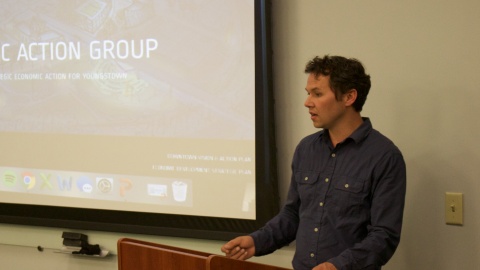By Sam Phillips
A class of economics students from Youngstown State University presented research to community members at last Tuesday’s Economic Action Group meeting at the Youngstown Business Incubator.

AJ Sumell, associate professor of economics at YSU, had students in his Urban and Regional Economics class work in collaboration with the Regional Economic Development Initiative. The students used surveys to gauge people’s attitudes on the city’s downtown.
“They just really dove into the project, and so I’m really happy with what they did and what they came up with,” Sumell said.
The students surveyed a total of 455 people comprising 210 student consumers, 212 downtown patrons and 33 business owners.
The four main takeaways were that the city needs to focus on improving livability, walkability, parking and cohesive marketing.
Two major findings are that 60 percent of student respondents said they avoid downtown because it is unsafe, and 70 percent said they would come downtown more often if parking was easier, even though their studies have shown the city’s parking lots never reach capacity.
Jillian Smith, a student that participated in the project, said there is a disconnect between perception and reality on these issues.
“Crime isn’t necessarily a problem,” Smith said. “But the perception pervades and causes that lack of participation and engagement with the downtown area.”
On the parking front, a student who presented said better signage could improve the problem.
“Maybe we can create some new signage to help direct people to that parking,” the student said. “60 percent of business owners say their customers complain about parking.”
Surveys also indicated that 43 percent of respondents said there weren’t enough bars and restaurants downtown.
Sumell said a lot of what students think about downtown reflect past perceptions of the area.
“I think one of the most important parts is trying to change the perception and improving the marketing of downtown,” Sumell said. “[Students] don’t necessarily know about the progress that’s been made over the past ten years — the fact that it is relatively safe and you can walk after 5 p.m. in downtown and not worry about a crime being committed or that there are all these bars and restaurants along Federal.”
Drawing on the fact that 83.5 percent of people that responded said they get their information from social media, the students suggested the city hire a social media manager to get information to patrons and create a cohesive marketing approach. This would help businesses promote one another, and could theoretically draw more students downtown.
Sumell said this has the potential to be a mutually beneficial relationship, and the city’s progress will be based on the ability to get YSU students more invested in the downtown community.
“It’s not just the city of Youngstown that benefits but also YSU, because it makes it look like a more attractive destination,” Sumell said. “Because it’s not just a place you go to school and leave. It’s a place where you can walk to a bar or go to a good restaurant with your friends.”
Smith said she was surprised that 60 percent of businesses said they would be interested in doing collaborative marketing.
“When you think about businesses, you think ‘oh there’s competition between them,’” Smith said. “But this is one very special aspect of this community … it’s a unique thing where they are seeing the value of businesses helping each other.”
She also said livability is a primary concern. She said the city is doing lots of really cool stuff that has generated some wealth, but to continue to be successful, the city needs to reinvest that wealth back into basic things, like making sure potholes are filled and street lights are working.
“I think once you lay that foundation, everything is limitless from there,” Smith said. “Because that’s what [residents] are confronted with day to day.”
Smith, who interns at the Regional Economic Development Initiative, said she and her teammates brought the idea of collaborating with the Urban and Regional Economics class to Sumell. He liked the idea of a service-learning project.
“We really wanted to use the students as the primary actors here but in doing so having their academic research actually contribute to real world issues and problems,” Sumell said.
He said it’s important to get students more involved in the community through their learning by doing projects that are applied and not just theoretical.
“To actually have the students look at the specific situation and look at ways to solve those problems, I think is a great thing,” Sumell said.

I dont believe that the crime statistic or perception of crime can be completely abandoned. Not only are there shootings following patrons going downtown and returning to their homes, but I’ve been personally robbed there within the last 6 months..I appreciate the groundwork, but lets not set these students up for failure. Downtown has much more problems than parking.
I can only agree, and while the sample size might need to be expanded, lets just not ignore the elephant in the room. Girls, as well as guys, can’t feel comfortable letting loose if we cant feel safe. Parking might become an issue if business and patrons could ultimately feel safe, but first things first, safety should be a priority.